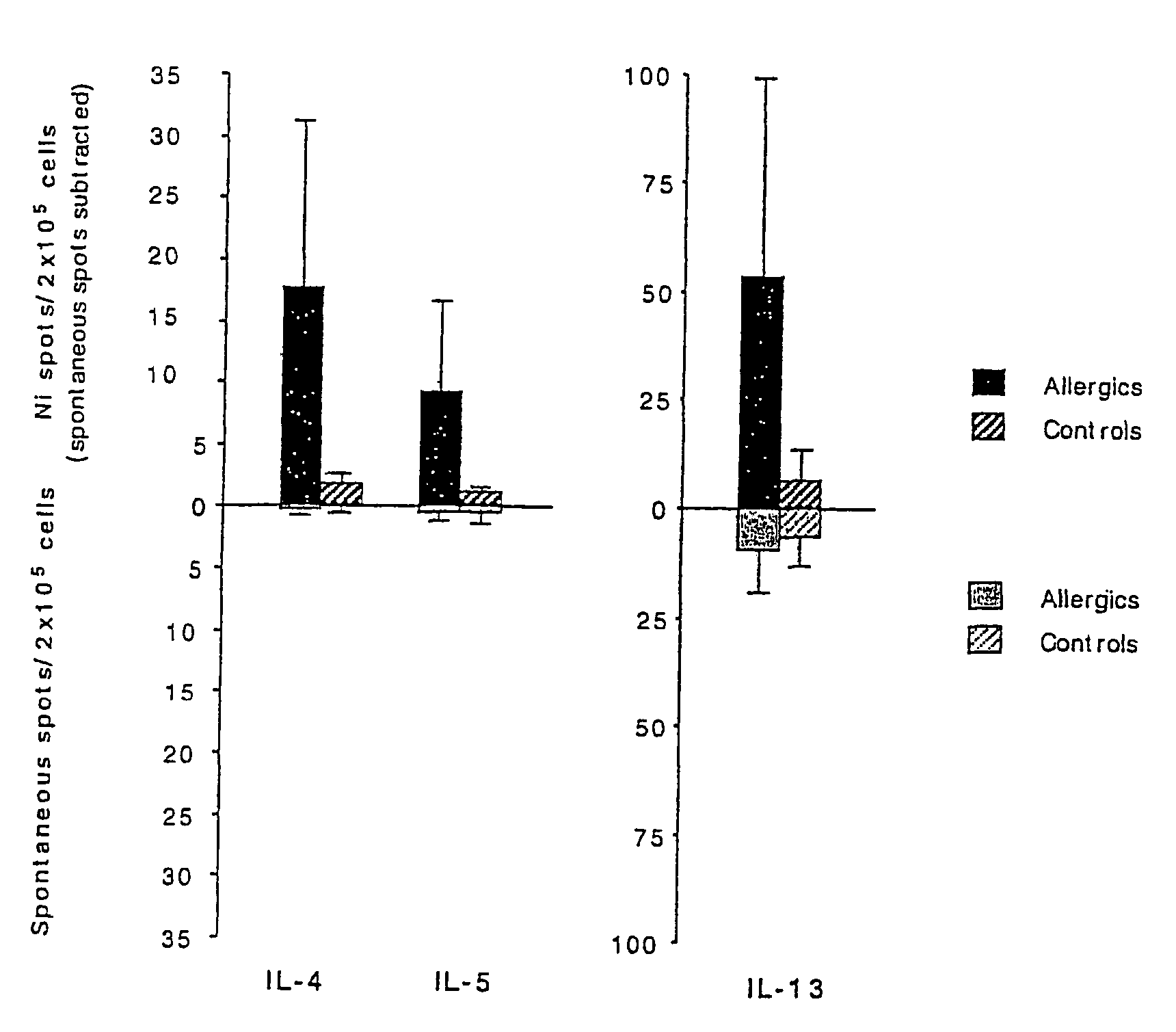Diagnosis of metal allergy through cytokine release by T-cells in vitro
a technology of cytokine release and allergy diagnosis, applied in the direction of material testing goods, measurement devices, instruments, etc., can solve the problems of nickel allergy, no effective treatment, and significant problem in general among peopl
- Summary
- Abstract
- Description
- Claims
- Application Information
AI Technical Summary
Problems solved by technology
Method used
Image
Examples
example 1
Selection of Patient and Control Subjects for Nickel-Allergy Testing
[0058]All individuals defined as nickel-induced allergic contact dermatitis (ACD) patients were selected based on previous history of ACD (n=11; age range 28-52; all female). Control individuals did not have a previously recorded problem with ACD (n=9; age range 40-54; all female). All individuals participated in the study after informed consent had been obtained and the project had been reviewed and accepted by the local ethic committee.
[0059]To confirm that the group of non-allergic controls did not include and potentially allergic individuals and that the patients were allergic to nickel, all individuals were patch tested. Prior to the patch testing of the control group, blood samples for ELISpot analysis were taken to avoid an impact of the patch test on the ELISpot analysis. Epicutaneous patch tests using 5% NiSO4 in petrolatum was applied for 48 h whereafter the reaction, sites were inspected. None of the cont...
example 2
Separation of Peripheral Blood Mononuclear Cells
[0061]Blood from ACD patients or control individuals were obtained by venipuncture and collected in sterile heparinised glass vials. Peripheral blood mononuclear cells (PBMC) were separated by density gradient centrifugation over Ficoll-Hypaque. After separation, PBMC were washed twice in medium (RPMI 1640 containing glutamin, Hepes, Penicillin / Streptomycin and 10% fetal calf serum (FCS)) and used fresh for experiments. Alternatively, PBMC were frozen in 90% FCS and 10% dimethylsulfoxide and kept in liquid nitrogen until tested. Prior to being tested, frozen cells were thawed at 37° C. and medium was added dropwise whereafter the cells were washed twice with medium. Comparison of the use of fresh and frozen cells in ELISpot with regard to cytokine responses to NiCl2 or other stimuli resulted in comparable number of spots.
example 3
Stimulation of PBMC
[0062]The PBMC were stimulated with various concentrations of NiCl2 and both proliferative responses and cytokine responses were analysed. NiCl2 at a stock concentration of 50 mM was mixed with medium and incubated for more than five minutes before being added to cells. PBMC diluted to a cell concentration of 4-6×106 cells / ml were mixed with an equal volume of NiCl2 diluted in medium resulting in a final concentration of 2×106 cells / ml and NiCl2 at concentrations ranging from 10-100 μM. The cell suspensions were incubated in plastic vials for 4 h at 37° C. in a humidified incubator. In parallel with incubating PBMC with NiCl2, PBMC at the same concentration were incubated with mitogen (1 μg phytohemagglutinin (PHA) / ml), control antigens (10 μg tetanus toxoid (TT) or purified protein derivative (PPD) / ml) or in the absence of stimuli. Comparison of ELISpot cytokine responses induced by NiCl2 and NiSO4 in a limited number of individuals resulted in similar responses....
PUM
 Login to View More
Login to View More Abstract
Description
Claims
Application Information
 Login to View More
Login to View More - R&D
- Intellectual Property
- Life Sciences
- Materials
- Tech Scout
- Unparalleled Data Quality
- Higher Quality Content
- 60% Fewer Hallucinations
Browse by: Latest US Patents, China's latest patents, Technical Efficacy Thesaurus, Application Domain, Technology Topic, Popular Technical Reports.
© 2025 PatSnap. All rights reserved.Legal|Privacy policy|Modern Slavery Act Transparency Statement|Sitemap|About US| Contact US: help@patsnap.com

